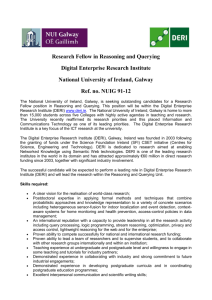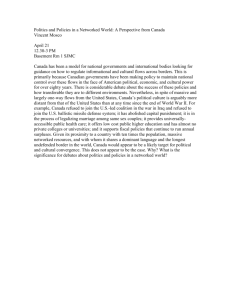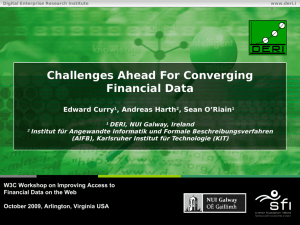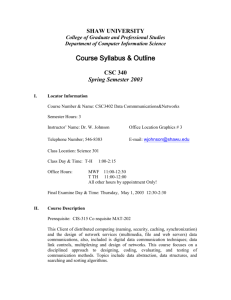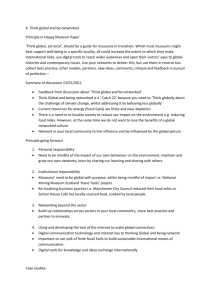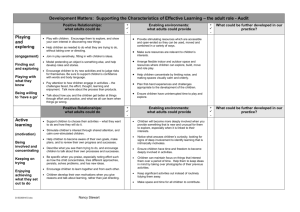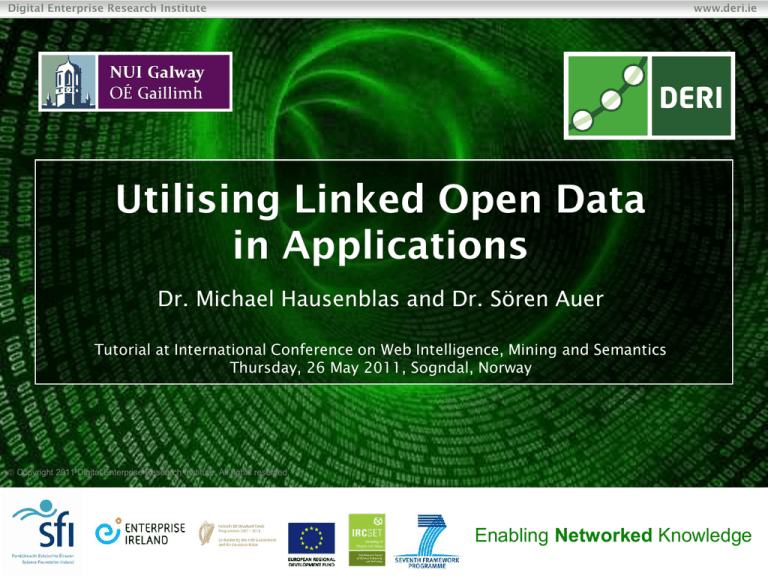
Digital Enterprise Research Institute
www.deri.ie
Utilising Linked Open Data
in Applications
Dr. Michael Hausenblas and Dr. Sören Auer
Tutorial at International Conference on Web Intelligence, Mining and Semantics
Thursday, 26 May 2011, Sogndal, Norway
Copyright 2011 Digital Enterprise Research Institute. All rights reserved.
Enabling Networked Knowledge
Outline
Digital Enterprise Research Institute
www.deri.ie
Linked Data 101
The Linked Open Data cloud
Discovery and Access of Linked Data
Querying Linked Data
Enabling Networked Knowledge
Organisational Notes
Digital Enterprise Research Institute
www.deri.ie
Michael will do the first session, Sören will do the
second session
If you have questions:
Use WebIRC back-channel
–
–
Go to http://webchat.freenode.net/
Join the #wims-tutorial channel
Tweet about the question using the #wims-tutorial
hash tag
Drop me a mail at michael.hausenblas@deri.org
Enabling Networked Knowledge
Digital Enterprise Research Institute
www.deri.ie
Linked Data 101
Enabling Networked Knowledge
Orientation
Digital Enterprise Research Institute
5
www.deri.ie
Enabling Networked Knowledge
Linked Data 101
Digital Enterprise Research Institute
www.deri.ie
Linked Data provides a standardised API for:
Data and metadata discovery
Data integration
Distributed query
6
Enabling Networked Knowledge
Linked Data principles
Digital Enterprise Research Institute
www.deri.ie
1.
Use URIs to identify the “things” in your data
2.
Use http:// URIs so people (and machines) can
look them up on the web
3.
When a URI is looked up, return a description of
the thing (in RDF format)
4.
Include links to related things
http://www.w3.org/DesignIssues/LinkedData.html
Enabling Networked Knowledge
Linked Data principles
Digital Enterprise Research Institute
8
www.deri.ie
They are principles, not implementation advices
Not humans or machines but humans and
machines!
Content negotiation (e.g. HTML and RDF/XML)
HTML+ RDFa
Metcalfe’s Law
http://en.wikipedia.org/wiki/Metcalfe%27s_law
Enabling Networked Knowledge
Linked Data example
Digital Enterprise Research Institute
www.deri.ie
9
Enabling Networked Knowledge
HTTP URIs
Digital Enterprise Research Institute
www.deri.ie
A Uniform Resource Identifier (URI) is a compact
sequence of characters that identifies an abstract
or physical resource. [RFC3986]
Syntax
URI = scheme ":" hier-part [ "?" query ] [ "#" fragment ]
Example
foo://example.com:8042/over/there?name=ferret#nose
\_/
\_________________/\_________/ \__________/ \__/
|
scheme
|
|
authority
path
10
|
|
query fragment
Enabling Networked Knowledge
HTTP URIs
Digital Enterprise Research Institute
www.deri.ie
Don’t confuse scheme with protocol
Scheme: defines URI layout and semantics
Protocol: defines communication means between
endpoints (such as HTTP or FTP)
URI resolution (as of RFC3986):
STEP
1:
2E:
2E:
2E:
2B:
2C:
2C:
2E:
OUTPUT BUFFER
/a
/a/b
/a/b/c
/a/b/c
/a/b
/a
/a/g
INPUT BUFFER
/a/b/c/./../../g
/b/c/./../../g
/c/./../../g
/./../../g
/../../g
/../g
/g
11
Enabling Networked Knowledge
HTTP URIs
Digital Enterprise Research Institute
www.deri.ie
URI references
An RDF URI reference is a Unicode string does not contain
any control characters (#x00 - #x1F, #x7F-#x9F) and would
produce a valid URI character sequence representing an
absolute URI when subjected to an UTF-8 encoding along
with %-escaping non-US-ASCII octets.
Qualified Names (QNames)
XML’s way to allow namespaced elements/attributes as of
QName = Prefix ‘:‘ LocalPart
Compact URIs (CURIEs)
Generic, abbreviated syntax for expressing URIs
12
Enabling Networked Knowledge
HTTP
Digital Enterprise Research Institute
www.deri.ie
The Hypertext Transfer Protocol (HTTP) is an
application-level protocol for distributed,
collaborative, hypermedia information systems.
It is a generic, stateless, protocol which can be used
for many tasks beyond its use for hypertext, such as
name servers and distributed object management
systems, through extension of its request methods,
error codes and headers.
A feature of HTTP is the typing and negotiation of
data representation, allowing systems to be built
independently of the data being transferred.
13
Enabling Networked Knowledge
HTTP
Digital Enterprise Research Institute
www.deri.ie
HTTP messages consist of requests from client to
server and responses from server to client
Set of methods is predefined
GET
POST
PUT
DELETE
HEAD
(OPTIONS)
14
Enabling Networked Knowledge
HTTP
Digital Enterprise Research Institute
www.deri.ie
Status codes
Informational 1xx, provisional response, (100 Continue)
Successful 2xx, request successfully received,
understood, and accepted (201 Created)
Redirection 3xx, further action needs to be taken by
user agent to fulfill the request (301 Moved
Permanently)
Client Error 4xx, client erred (405 Method Not Allowed)
Server Error 5xx, server encountered an unexpected
condition (501 Not Implemented)
15
Enabling Networked Knowledge
HTTP
REQUEST
Digital Enterprise Research Institute
www.deri.ie
GET /html/rfc2616 HTTP/1.1
Host: tools.ietf.org
User-Agent: Mozilla/5.0
RESPONSE
Accept:
text/html,application/xhtml+xml,application/xml
;q=0.9,*/*;q=0.8
HTTP/1.x 200 OK
Date: Thu, 05 Mar 2009 08:17:33 GMT
Server: Apache/2.2.11
Content-Location: rfc2616.html
Last-Modified: Tue, 20 Jan 2009 09:16:04 GMT
Content-Type: text/html; charset=UTF-8
16
Enabling Networked Knowledge
HTTP
Digital Enterprise Research Institute
www.deri.ie
Content Negotiation: selecting representation for a
given response when multiple representations
available
Three types of CN: server-driven, agent-driven CN,
transparent CN
Example:
curl -I -H "Accept: application/rdf+xml" http://dbpedia.org/resource/Galway
HTTP/1.1 303 See Other
Content-Type: application/rdf+xml
Location: http://dbpedia.org/data/Galway.rdf
17
Enabling Networked Knowledge
HTTP
Digital Enterprise Research Institute
www.deri.ie
Caching (see Cache–Control header field) is
essential for scalability
http://webofdata.wordpress.com/2009/11/23/linked-open-data-http-caching/
HTTPbis IETF WG chaired by Mark Nottingham,
mainly about: patches, clarifications, deprecate
non-used features, documentation of security
properties
18
Enabling Networked Knowledge
REST - HTTP
Digital Enterprise Research Institute
www.deri.ie
Representational State Transfer (REST)
resource
intended conceptual target of a hypertext reference
resource identifier
URL, URN
representation
HTML document, JPEG image
representation
metadata
media type, last-modified time
resource
metadata
source link, alternates, vary
control data
if-modified-since, cache-control
http://www.ics.uci.edu/~fielding/pubs/dissertation/top.htm
http://webofdata.wordpress.com/2009/10/09/linked-data-for-restafarians/
19
Enabling Networked Knowledge
RDF
Digital Enterprise Research Institute
www.deri.ie
A data model - directed, labeled graph
Triple: (subject predicate object)
subject … URIref or bNode
predicate … URIref
object … URIref or bNode or literal
20
Enabling Networked Knowledge
RDF
Digital Enterprise Research Institute
www.deri.ie
21
Enabling Networked Knowledge
Vocabularies
Digital Enterprise Research Institute
www.deri.ie
Schema layer of RDF
Defines terms (classes and properties)
Typically RDFS or OWL family
Common vocabularies:
Dublin Core, SKOS
FOAF, SIOC, vCard
DOAP
Core Organization Ontology
VoID
http://www.slideshare.net/prototypo/introduction-to-linked-data-rdf-vocabularies
Enabling Networked Knowledge
Vocabulary Management
Digital Enterprise Research Institute
www.deri.ie
http://vocab.deri.ie/
Neologism - Drupal-based RDF-S vocabulary
editor and publishing system:
• Collaborativelly creating and maintaining
RDFS vocabularies
• Making the vocab available for humans
(HTML, graph) and machines (RDF/XML,
Turtle)
• Importing external vocabularies
• Working with external namespaces such
as via PURL.org, etc.
• More at http://neologism.deri.ie/
Enabling Networked Knowledge
Web's Standard Retrieval Algorithm
Digital Enterprise Research Institute
www.deri.ie
1. parse URI and find HTTP protocol
2. look up DNS name to determine the associated
IP address
3. open a TCP stream to port 80 at the IP address
determined above
4. format an HTTP GET request for resource and
sends that to the server
5. read response from the server
6. from the status code (200) determine that a
representation of the resource is available
7. inspect the returned Content-Type
8. pass the entity-body to its HTML rendering
engine
http://www.w3.org/2001/tag/doc/selfDescribingDocuments
Enabling Networked Knowledge
Digital Enterprise Research Institute
www.deri.ie
The
Linked Open Data cloud
Enabling Networked Knowledge
Linked Open Data cloud
2008
2008
2008
2009
2008
2007
26
2010
2009
Linked Open Data cloud
Media
User-generated
Government
Publications
Cross-domain
Geo
http://lod-cloud.net/
Life sciences
LOD cloud stats
Digital Enterprise Research Institute
www.deri.ie
triples distribution
links distribution
http://lod-cloud.net/state/
Enabling Networked Knowledge
Hans Rosling
‘database hugging disorder’
http://thinkquarterly.co.uk/01-data/a-data-state-of-mind/
TimBL’s 5-star plan for open data
the
★ Make your data available on
Web under an open license
★★ Make it available as structured
data
(Excel sheet instead of image scan of a table)
★★★ Use a non-proprietary format
(CSV file instead of an Excel sheet)
★★★★ Use Linked Data format
(URIs to identify things, RDF to represent data)
★★★★★ Link your data to other
people’s data to provide
context
More: http://lab.linkeddata.deri.ie/2010/star-scheme-by-example/
Why going for the 5th star?
Central Contractor Registration (CCR)
Geonames
http://webofdata.wordpress.com/2011/05/22/why-we-link/
Effort distribution
Digital Enterprise Research Institute
Fix
Overall Data
Integration
Effort
www.deri.ie
Publisher‘s
Effort
Third
Party
Effort
Consumer‘s
Effort
Enabling Networked Knowledge
Datasets
Digital Enterprise Research Institute
www.deri.ie
A dataset is a set of RDF triples that are published,
maintained or aggregated by a single provider
Enabling Networked Knowledge
Linksets
Digital Enterprise Research Institute
www.deri.ie
An RDF link is an RDF triple whose subject and
object are described in different datasets
A linkset is a collection of such RDF links between
two datasets
Enabling Networked Knowledge
Describing Datasets - VoID
Digital Enterprise Research Institute
www.deri.ie
General dataset metadata
Access metadata
Structural metadata
Describing linksets
Deployment and discovery of voiD files
http://www.w3.org/TR/void/
Enabling Networked Knowledge
General dataset metadata
Digital Enterprise Research Institute
www.deri.ie
Dataset homepage
Publisher
Title and description
Categorisation
Licensing
Technical features
Enabling Networked Knowledge
General dataset metadata
Digital Enterprise Research Institute
www.deri.ie
:DBpedia a void:Dataset ;
dcterms:title "DBPedia” ;
dcterms:description "RDF data extracted from Wikipedia” ;
dcterms:contributor :FU_Berlin ;
dcterms:source <http://dbpedia.org/resource/Wikipedia> ;
void:feature <http://www.w3.org/ns/formats/RDF_XML> ;
dcterms:modified "2008-11-17"^^xsd:date .
:Geonames a void:Dataset ;
dcterms:subject <http://dbpedia.org/resource/Location> .
:GeoSpecies a void:Dataset ;
dcterms:license <http://creativecommons.org/licenses/by-sa/3.0/us/> .
Enabling Networked Knowledge
Access metadata
Digital Enterprise Research Institute
www.deri.ie
SPARQL endpoints
RDF data dumps
Root resources
URI lookup endpoints
OpenSearch description documents
Enabling Networked Knowledge
Access metadata
Digital Enterprise Research Institute
www.deri.ie
:exampleDS void:Dataset ;
void:sparqlEndpoint <http://example.org/sparql> ;
void:dataDump <http://example.org/dump1.rdf> ;
void:uriLookupEndpoint <http://api.example.org/search?qt=term> .
Enabling Networked Knowledge
Structural metadata
Digital Enterprise Research Institute
www.deri.ie
Provides high-level information about the schema
and internal structure of a dataset and can be
helpful when exploring or querying datasets:
Example resources
Patterns for resource URIs
Vocabularies
Dataset partitions
Statistics
Enabling Networked Knowledge
Structural metadata
Digital Enterprise Research Institute
www.deri.ie
:DBpedia a void:Dataset;
void:exampleResource <http://dbpedia.org/resource/Berlin> .
:LiveJournal a void:Dataset;
void:vocabulary <http://xmlns.com/foaf/0.1/> .
:DBpedia a void:Dataset;
void:classPartition [
void:class foaf:Person;
void:entities 312000;
];
void:propertyPartition [
void:property foaf:name;
void:triples 312000;
];
.
Enabling Networked Knowledge
Describing linksets
Digital Enterprise Research Institute
www.deri.ie
Enabling Networked Knowledge
Describing linksets
Digital Enterprise Research Institute
www.deri.ie
:DBpedia a void:Dataset ;
void:subset :DBpedia2Geonames .
:Geonames a void:Dataset .
:DBpedia2Geonames a void:Linkset ;
void:target :DBpedia ;
void:target :Geonames ;
void:linkPredicate owl:sameAs .
Enabling Networked Knowledge
Deployment and discovery
Digital Enterprise Research Institute
www.deri.ie
Choosing URIs for datasets
Publishing a VoID file alongside a dataset
Turtle
RDFa
SPARQL Service Description Vocabulary
http://www.w3.org/TR/sparql11-service-description/
Discovery (well-known URI), based on of RFC5758],
registered with IANA
http://www.example.com/.well-known/void
Enabling Networked Knowledge
Digital Enterprise Research Institute
www.deri.ie
Discovery and Access
of Linked Data
Enabling Networked Knowledge
Linked Data Life-cycle
Digital Enterprise Research Institute
www.deri.ie
6. Use cases
5. Integration
4. Discovery
3. Publishing
2. Modeling
1. Data awareness
Enabling Networked Knowledge
Data awareness
Digital Enterprise Research Institute
www.deri.ie
6. Use cases
To raise awareness regarding
government data in Ireland and
establish a community around open
data access and usage.
DERI in-house
CSO/schools pilot
5. Integration
LATC
Sig.ma
4. Discovery
3. Publishing
VoID/DCAT
Sindice
CKAN
Google Refine plug-in
RDB2RDF/D2R
2. Modeling
Neologism
DataCube
prefix.cc
1. Data awareness
opendata.ie
LOD cloud
Enabling Networked Knowledge
Data awareness
Digital Enterprise Research Institute
www.deri.ie
http://opendata.ie
Community building
Enabling Networked Knowledge
Data awareness
Digital Enterprise Research Institute
www.deri.ie
http://ie.ckan.net
Irish data catalog
Enabling Networked Knowledge
Modeling
Digital Enterprise Research Institute
www.deri.ie
6. Use cases
Model and share vocabularies on
the Web (Drupal plug-in). Exposes
vocabulary both human-friendly
and machine-readable (RDF/XML,
N3).
3. Publishing
DERI in-house
CSO/schools pilot
5. Integration
LATC
Sig.ma
4. Discovery
VoID/DCAT
Sindice
CKAN
Google Refine plug-in
RDB2RDF/D2R
2. Modeling
Neologism
DataCube
prefix.cc
1. Data awareness
opendata.ie
LOD cloud
Enabling Networked Knowledge
Modeling
Digital Enterprise Research Institute
www.deri.ie
http://vocab.deri.ie
http://neologism.deri.ie
Enabling Networked Knowledge
Publishing
Digital Enterprise Research Institute
www.deri.ie
6. Use cases
DERI in-house
CSO/schools pilot
Mapping and exporting data of
Google Refine projects in RDF
format.
5. Integration
LATC
Sig.ma
4. Discovery
3. Publishing
VoID/DCAT
Sindice
CKAN
Google Refine plug-in
RDB2RDF/D2R
2. Modeling
Neologism
DataCube
prefix.cc
1. Data awareness
opendata.ie
LOD cloud
Enabling Networked Knowledge
Publishing
Digital Enterprise Research Institute
www.deri.ie
http://lab.linkeddata.deri.ie/2010/grefine-rdf-extension/
Enabling Networked Knowledge
Discovery
Digital Enterprise Research Institute
www.deri.ie
6. Use cases
DERI in-house
CSO/schools pilot
Describe and explore LOD
datasets with VoID.
5. Integration
LATC
Sig.ma
4. Discovery
3. Publishing
VoID/DCAT
Sindice
CKAN
Google Refine plug-in
RDB2RDF/D2R
2. Modeling
Neologism
DataCube
prefix.cc
1. Data awareness
opendata.ie
LOD cloud
Enabling Networked Knowledge
Discovery
Digital Enterprise Research Institute
www.deri.ie
http://lab.linkeddata.deri.ie/vox/
VoID editor
http://lab.linkeddata.deri.ie/ve2/
More: http://www.w3.org/TR/void/
55 of XYZ
VoID explorer
Enabling Networked Knowledge
Integration
Digital Enterprise Research Institute
www.deri.ie
6. Use cases
DERI in-house
CSO/schools pilot
24/7 Interlinking platform to
enrich the LOD cloud and foster
new applications.
5. Integration
LATC
Sig.ma
4. Discovery
3. Publishing
VoID/DCAT
Sindice
CKAN
Google Refine plug-in
RDB2RDF/D2R
2. Modeling
Neologism
DataCube
prefix.cc
1. Data awareness
opendata.ie
LOD cloud
Enabling Networked Knowledge
Integration
Digital Enterprise Research Institute
www.deri.ie
http://latc-project.eu
Enabling Networked Knowledge
Use Cases
Digital Enterprise Research Institute
www.deri.ie
6. Use cases
Understand DERI as an enterprise
and demo how to integrate a
range of data sources (rooms,
groups, location, people profiles).
DERI in-house
CSO/schools pilot
5. Integration
LATC
Sig.ma
4. Discovery
3. Publishing
VoID/DCAT
Sindice
CKAN
Google Refine plug-in
RDB2RDF/D2R
2. Modeling
Neologism
DataCube
prefix.cc
1. Data awareness
opendata.ie
LOD cloud
Enabling Networked Knowledge
Use Cases
Digital Enterprise Research Institute
www.deri.ie
DERI Guide
Enabling Networked Knowledge
Consumption - Essentials
Digital Enterprise Research Institute
www.deri.ie
Linked Data provides for a global data-space with a
uniform API (due to RDF as the data model)
Access methods
Dereference URIs via HTTP GET (RDF/XML, RDFa, etc.)
SPARQL (‘the SQL of RDF’)
Data dumps (RDF/XML, etc.)
Enabling Networked Knowledge
Consumption - Technologies
Digital Enterprise Research Institute
www.deri.ie
Linked Data access mechanisms widely supported
all major platforms and languages (HTTP interface & RDF
parsing), such as Java, Python, PHP, C/C++/.NET, etc.
Command line tools (curl, rapper, etc.)
Online tools
– http://redbot.org/ (HTTP/low-level)
– http://sindice.com/developers/inspector (RDF/data-level)
Structured query: SPARQL (more later)
Enabling Networked Knowledge
Consumption - Technologies
Digital Enterprise Research Institute
Distributed setup need for central point of
access (indexer, aggregator)
Sindice, an index of the Web of Data
http://sindice.com/
Sig.ma, Web of Data aggregator & browser
www.deri.ie
http://sig.ma/
Relationship discovery
http://relfinder.semanticweb.org/
Enabling Networked Knowledge
Technologies – FYN
Digital Enterprise Research Institute
www.deri.ie
http://dbpedia.org/resource/Galway
63
Enabling Networked Knowledge
Technologies – Sig.ma
Digital Enterprise Research Institute
www.deri.ie
Sig.ma is a Web of
Data platform
enabling entity
visualisation and
consolidation both for
humans and
machines (API)
http://sig.ma/search?q=Galway
64
Enabling Networked Knowledge
Technologies – sameas.org
Digital Enterprise Research Institute
www.deri.ie
Sameas.org is a
service to find coreferences on the
Web of Data
http://sameas.org/html?q=Galway
Enabling Networked Knowledge
Digital Enterprise Research Institute
www.deri.ie
Querying Linked Data
Enabling Networked Knowledge
The following slides are based on:
SPARQL By Example: The Cheat Sheet
http://www.slideshare.net/LeeFeigenbaum/sparql-cheat-sheet
Lee Feigenbaum <lee@cambridgesemantics.com>
VP Technology & Standards, Cambridge Semantics
Co-chair, W3C SPARQL Working Group
Nuts & Bolts
URIs
Write full URIs:
<http://this.is.a/full/URI/written#out>
Abbreviate URIs with prefixes:
PREFIX foo: <http://this.is.a/URI/prefix#>
… foo:bar …
http://this.is.a/URI/prefix#bar
Shortcuts:
a
rdf:type
Variables
Literals
Plain literals:
“a plain literal”
Plain literal with language tag:
“bonjour”@fr
Typed literal:
“13”^^xsd:integer
Shortcuts:
true “true”^^xsd:boolean
3
“3”^^xsd:integer
4.2 “4.2”^^xsd:decimal
Comments
Variables:
?var1, ?anotherVar, ?and_one_more
Comments:
# Comments start with a ‘#’
# continue to the end of the line
Triple Patterns
Match an exact RDF triple:
ex:myWidget ex:partNumber “XY24Z1” .
Match one variable:
?person foaf:name “Lee Feigenbaum” .
Match multiple variables:
conf:SemTech2009 ?property ?value .
Common Prefixes
prefix...
…stands for
rdf:
http://xmlns.com/foaf/0.1/
rdfs:
http://www.w3.org/2000/01/rdfschema#
owl:
http://www.w3.org/2002/07/owl#
xsd:
http://www.w3.org/2001/XMLSchema#
dc:
http://purl.org/dc/elements/1.1/
foaf:
http://xmlns.com/foaf/0.1/
More common prefixes at http://prefix.cc
Anatomy of a Query
Declare prefix
shortcuts
(optional)
Define the
dataset (optional)
Query modifiers
(optional)
PREFIX foo: <…>
PREFIX bar: <…>
…
SELECT …
FROM <…>
FROM NAMED <…>
WHERE {
…
}
GROUP BY …
HAVING …
ORDER BY …
LIMIT …
OFFSET …
BINDINGS …
Query result
clause
Query pattern
4 Types of SPARQL Queries
SELECT queries
Project out specific variables and expressions:
SELECT ?c ?cap (1000 * ?people AS ?pop)
Project out all variables:
SELECT *
Project out distinct combinations only:
SELECT DISTINCT ?country
Results in a table of values (in XML or JSON):
?c
?cap
?pop
ex:France
ex:Paris
63,500,000
ex:Canada
ex:Ottawa
32,900,000
ex:Italy
ex:Rome
58,900,000
ASK queries
Ask whether or not there are any matches:
ASK
Result is either “true” or “false” (in XML or JSON):
true, false
CONSTRUCT queries
Construct RDF triples/graphs:
CONSTRUCT {
?country a ex:HolidayDestination ;
ex:arrive_at ?capital ;
ex:population ?population .
}
Results in RDF triples (in any RDF serialization):
ex:France a ex:HolidayDestination ;
ex:arrive_at ex:Paris ;
ex:population 635000000 .
ex:Canada a ex:HolidayDestination ;
ex:arrive_at ex:Ottawa ;
ex:population 329000000 .
DESCRIBE queries
Describe the resources matched by the given
variables:
DESCRIBE ?country
Result is RDF triples (in any RDF serialization) :
ex:France a geo:Country ;
ex:continent geo:Europe ;
ex:flag <http://…/flag-france.png> ;
…
Combining SPARQL Graph Patterns
Consider A and B as graph patterns.
A Basic Graph Pattern – one or more triple patterns
A . B
Conjunction. Join together the results of solving A and B by
matching the values of any variables in common.
Optional Graph Patterns
A OPTIONAL { B }
Left join. Join together the results of solving A and B by
matching the values of any variables in common, if possible. Keep all
solutions from A whether or not there’s a matching solution in B
Combining SPARQL Graph Patterns
Consider A and B as graph patterns.
Either-or Graph Patterns
{ A } UNION { B }
Disjunction. Include both the results of solving A and the
results of solving B.
“Subtracted” Graph Patterns
(SPARQL 1.1)
A MINUS { B }
Negation. Solve A. Solve B. Include only those results from
solving A that are not compatible with any of the results from B.
SPARQL Filters
SPARQL FILTERs eliminate solutions that do not
cause an expression to evaluate to true.
Place FILTERs in a query inline within a basic
graph pattern
A . B . FILTER ( …expr… )
Category
Functions /
Operators
Examples
Logical
!, &&, ||, =, !=, <,
<=, >, >=
?hasPermit || ?age < 25
Math
+, -, *, /
?decimal * 10 > ?minPercent
Existence
EXISTS, NOT EXISTS
NOT EXISTS { ?p foaf:mbox ?email }
SPARQL tests
isURI, isBlank,
isLiteral, bound
isURI(?person) || !bound(?person)
Accessors
str, lang, datatype
lang(?title) = “en”
(SPARQL 1.1)
Miscellaneous
sameTerm,
regex(?ssn, “\\d{3}-\\d{2}-\\d{4}”)
RDF Datasets
A SPARQL queries a default graph (normally) and
zero or more named graphs (when inside a GRAPH
Default graph
clause). PREFIX ex: <…>
(the merge of zero or more
graphs)
ex:g1
ex:g4
Named graphs
ex:g3
ex:g1
OR
ex:g2
OR
SELECT …
FROM ex:g1
FROM ex:g4
FROM NAMED ex:g1
FROM NAMED ex:g2
FROM NAMED ex:g3
WHERE {
… A …
GRAPH ex:g3 {
… B …
}
GRAPH ?g {
… C …
}
}
SPARQL Over HTTP (the SPARQL Protocol)
http://host.domain.com/sparql/endpoint?<parameters>
where <parameters> can include:
query=<encoded query string>
e.g. SELECT+*%0DWHERE+{…
default-graph-uri=<encoded graph URI>
e.g. http%3A%2F%2Fexmaple.com%2Ffoo…
n.b. zero of more occurrences of defaultgraph-uri
named-graph-uri=<encoded graph URI>
e.g. http%3A%2F%2Fexmaple.com%2Fbar…
n.b. zero of more occurrences of named-graphuri
Federated Query (SPARQL 1.1)
Local Graph Store
ex:g1
SPARQL
Endpoint
ex:s1
Web
SPARQL
Endpoint
ex:s2
PREFIX ex: <…>
SELECT …
FROM ex:g1
WHERE {
… A …
SERVICE ex:s1 {
… B …
}
SERVICE ex:s2 {
… C …
}
}
SPARQL 1.1 Update
SPARQL Update Language Statements
INSERT DATA { triples }
DELETE DATA {triples}
[ DELETE { template } ] [ INSERT { template } ] WHERE { pattern }
LOAD <uri> [ INTO GRAPH <uri> ]
CLEAR GRAPH <uri>
CREATAE GRAPH <uri>
DROP GRAPH <uri>
[ … ] denotes optional parts of SPARQL 1.1 Update syntax
Some Public SPARQL Endpoints
Name
URL
What’s there?
SPARQLer
http://sparql.org/sparql.html
General-purpose query endpoint
for Web-accessible data
DBPedia
http://dbpedia.org/sparql
Extensive RDF data from
Wikipedia
DBLP
http://www4.wiwiss.fu-berlin.de/dblp/snorql/
Bibliographic data from
computer science journals and
conferences
LinkedMDB
http://data.linkedmdb.org/sparql
Films, actors, directors, writers,
producers, etc.
World
Factbook
http://www4.wiwiss.fu-berlin.de/factbook/snorql/
Country statistics from the CIA
World Factbook
bio2rdf
http://bio2rdf.org/sparql
Bioinformatics data from around
40 public databases
SPARQL Resources
•
The SPARQL Specification
–
•
SPARQL implementations
–
•
–
http://www.thefigtrees.net/lee/sw/sparql-faq
SPARQL Working Group
–
•
http://esw.w3.org/topic/SparqlEndpoints
http://labs.mondeca.com/sparqlEndpointsStatus/
SPARQL Frequently Asked Questions
–
•
http://esw.w3.org/topic/SparqlImplementations
SPARQL endpoints
–
•
http://www.w3.org/TR/rdf-sparql-query/
http://www.w3.org/2009/sparql/wiki/
Common SPARQL extensions
–
http://esw.w3.org/topic/SPARQL/Extensions
Hands-on: Querying DBpedia
http://dbpedia.org/sparql
SELECT * WHERE {
<http://dbpedia.org/resource/Galway> ?p ?o .
}
81
Digital Enterprise Research Institute
www.deri.ie
Questions?
Enabling Networked Knowledge

